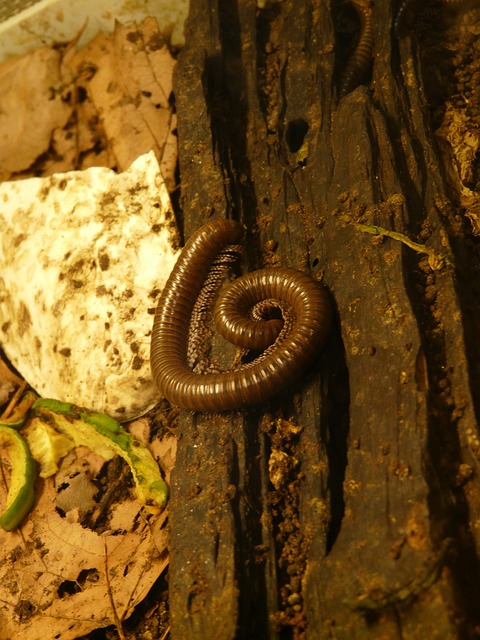Millipedes, common in damp areas, are natural decomposers but can indicate moisture issues. Effective millipede control plans focus on reducing humidity, sealing entry points, and maintaining cleanliness to prevent infestations. Eco-friendly methods include sealing with diatomaceous earth, planting aromatic herbs, using essential oils, and promoting beneficial insects. Long-term strategies involve regular trimming, proper drainage, and natural predator introduction for sustainable millipede control.
Millipedes might be tiny, but they can cause a big stink! These creatures, often found in damp environments, can invade homes seeking moisture. Understanding their behavior and habitat is crucial for effective millipede control plans. This article explores eco-friendly solutions to safely remove these insects, focusing on natural remedies and long-term prevention strategies. Learn how to navigate the labyrinth of millipede management without relying on harsh chemicals.
Understanding Millipedes: Behavior and Habitat
Millipedes are intriguing creatures, often misunderstood and maligned. Understanding their behavior and habitat is crucial in developing effective yet eco-friendly millipede control plans. These nocturnal insects prefer damp environments, commonly found in areas with high humidity like basements, bathrooms, or beneath debris and rocks in outdoor spaces. Their diet consists mainly of decaying organic matter, making them natural decomposers. However, when they invade living spaces, it’s often a sign that there’s excessive moisture or food sources nearby. Recognizing these triggers is key to preventing and managing millipede infestations.
Millipedes are known for their slow movement and tendency to avoid light, which makes them less of an immediate threat compared to other pests. They don’t bite or carry diseases, but their presence can signal underlying issues that need addressing. By implementing measures to reduce moisture, sealing entry points, and maintaining a clean environment, it’s possible to discourage millipedes from thriving in unwanted areas while preserving the ecological balance.
Eco-Friendly Methods for Millipede Prevention
Millipedes are often seen as a nuisance, but their presence can be managed through eco-friendly methods that align with sustainable living practices. One effective approach to millipede control is implementing preventive measures around your home or property. This involves creating an environment that discourages these creatures from taking up residence in the first place. For instance, sealing gaps and cracks in walls, floors, and foundations can prevent their entry. Regularly trimming vegetation and removing organic debris also reduces habitats that attract millipedes. Additionally, maintaining proper drainage systems keeps standing water at bay, as millipedes are drawn to damp environments.
Eco-friendly millipede control plans should also include natural deterrents. Certain plants like mint, lavender, and basil have scents that repel millipedes. Planting these aromatics around the perimeter of your property can act as a non-toxic barrier. Another strategy is using diatomaceous earth, a mineral compound that disrupts the exoskeletons of these creatures, leading to dehydration and death. This natural powder is safe for pets and humans but poses a significant threat to millipedes. Combining such organic solutions with regular inspections can effectively manage and prevent millipede infestations without resorting to harsh chemicals.
Natural Remedies for Safe and Effective Control
Millipedes are often considered a nuisance, but there are natural remedies that can help with their removal and control, ensuring a safe environment for both your home and local ecosystem. One effective approach is using essential oils known for their insect-repelling properties. Sprays or drops of peppermint, lemon eucalyptus, or neem oil mixed with water can be used to treat affected areas. These natural ingredients disrupt the millipedes’ scent trails and deter them from returning.
Creating a healthy garden environment by promoting beneficial insects is another part of a successful millipede control plan. Encouraging the presence of spiders, centipedes, and certain species of beetles helps keep millipede populations in check naturally. Removing excessive plant debris, maintaining proper soil moisture, and using organic compost can also deter millipedes, as they prefer dry, decomposing matter.
Implementing Long-Term Millipede Control Plans
Implementing long-term millipede control plans is essential for preventing infestations and maintaining a pest-free environment. Instead of relying on chemical pesticides, which can be harmful to both humans and the ecosystem, consider eco-friendly alternatives. One effective strategy is to enhance your property’s physical barriers by sealing entry points and ensuring proper sanitation. Regularly trimming vegetation and removing debris creates less favorable habitats for millipedes.
Additionally, introducing natural predators like certain species of ants or spiders can help regulate millipede populations. Planting herbs known to repel millipedes, such as lavender, mint, and lemongrass, around your home may also deter them. Maintaining a balanced ecosystem and adopting these organic millipede control plans will ensure long-term success in managing and controlling these creatures safely and sustainably.
In summary, effectively managing millipedes requires a combination of understanding their behavior, implementing eco-friendly prevention methods, and utilizing natural remedies. By adopting these strategies, homeowners can achieve safe and sustainable millipede control without resorting to harmful chemicals. Moreover, long-term millipede control plans that focus on habitat modification and regular monitoring are essential for maintaining a pest-free environment. Remember that with dedication and the right approach, it’s possible to coexist harmoniously with these fascinating creatures while keeping them at bay.
